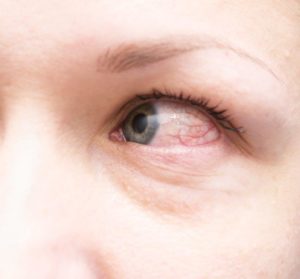 Red eyes are one of the most common conditions seen in an eye doctor’s office. Many people assume that if their eye is red that they have “pink eye”, when in fact a red eye can signify many different diagnoses. Pink eye is actually viral conjunctivitis which is only one cause of a red eye. Viral conjunctivitis, just as a cold, needs to run its course. Some doctors treat it with a mild steroid drop to relieve redness and irritation, but the virus still has to run its course for usually 10-12 days in order for the eye to heal. It is highly contagious. Common symptoms include tearing, itching, redness, clear discharge and light sensitivity. It is important not touch your eyes and to constantly wash your hands if you have this infection to prevent transmission.
Red eyes are one of the most common conditions seen in an eye doctor’s office. Many people assume that if their eye is red that they have “pink eye”, when in fact a red eye can signify many different diagnoses. Pink eye is actually viral conjunctivitis which is only one cause of a red eye. Viral conjunctivitis, just as a cold, needs to run its course. Some doctors treat it with a mild steroid drop to relieve redness and irritation, but the virus still has to run its course for usually 10-12 days in order for the eye to heal. It is highly contagious. Common symptoms include tearing, itching, redness, clear discharge and light sensitivity. It is important not touch your eyes and to constantly wash your hands if you have this infection to prevent transmission.
Besides viral conjunctivitis, there are two other main types: bacterial and allergic. Bacterial conjunctivitis can present with similar symptoms to viral except usually there is more of a green or yellow discharge coming from the eye. Many patients report waking up with their eyes “glued shut.”
It is usually treated with an antibiotic eye drop and takes about a week to heal. Allergic conjunctivitis main symptoms are redness and itching. The eye lid(s) may also be swollen with this more often than the other two types. An allergy eye drop is prescribed to treat this and sometimes is only needed for a week, but also can be needed long term depending on the individual’s allergy condition.
Dry eyes are another very common cause of red eyes. Symptoms are similar to conjunctivitis and can include burning, itching, tearing, redness and light sensitivity. Superficial keratitis (inflammatory particles on the cornea) are also very common with dry eyes on the cornea and can sometimes even result in eye pain. Dry eyes are treated many different ways including artificial tears, punctal plugs, prescription eye drops depending on the severity.
Not properly caring for contacts and contact lens over wear is another culprit of redness. Many contacts are only to be worn for 2 weeks or a month. Wearing each pair longer and not properly cleaning and caring for the contacts can result in this problem. If the eye becomes red while wearing contacts, the contacts should be removed immediately and an eye doctor should be consulted.
Corneal ulcers are another condition resulting in redness. A corneal ulcer’s main symptom is usually pain. Depending where on the eye the ulcer is located, the vision may be blurred. Ulcers on the outside of the cornea are known as marginal ulcers and usually do not affect vision if the swelling around them is not severe. Central corneal ulcers cause decreased vision and even vision loss if there is a central scar remaining after the ulcer heals. An ulcers first line treatment is an antibiotic eye drop.
Uveitis also most always results in eye redness. Uveitis is inflammation inside the eye and most commonly causes a red, light sensitive and very painful eye. Many times it is “idiopathic” meaning the cause is unknown. Other times, the cause is from an eye injury. However, if a patient has recurrent uveitis, the doctor will usually perform blood tests to rule out a systemic condition that is causing the inflammation. Iritis is treated with steroid eye drops, however, a pill or injection may also be used depending on the type of uveitis. Here is a list of some possible causes of recurrent uveitis:
These are just a few ocular conditions that can cause red eyes. We at Metrolina Eye treat these conditions daily. If you have any of these symptoms, we are here to take care of you.
| · multiple sclerosis · psoriatic arthritis · Reiter’s syndrome · sarcoidosis · systemic lupus erythematosus · Vogt-Koyanagi-Harada syndrome
|



